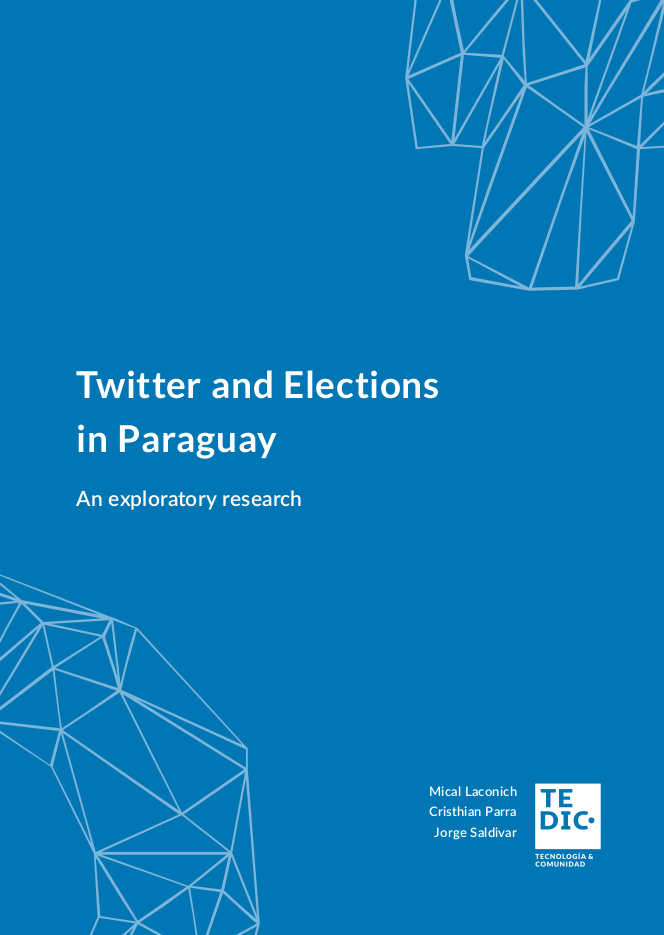
An exploratory research
Introduction
This is an exploratory research that monitors content generation on Twitter during electoral processes. It includes the analysis of Paraguay’s general elections held in April 2018 and the Colorado Party primaries held in December 2017, primaries where the current president was elected. Content monitoring was carried out using four methodological tools. The first tool is Twitter ́s
API used to collect tweets and the second tool is the bot detector. These tools help to identify the volume and type of content that was generated and to verify if bots and disinformation were used to manipulate public opinion. The third tool is the sentiment analysis which identifies how many tweets used negative language and, lastly the network of interactions that identifies which accounts were more influential on Twitter. Through these tools it is possible to explore the level of freedom of expression, violence and intimidation during elections. This research aims to investigate the existence of misinformation, censorship and violence on Twitter. Social media is the main mean people use to communicate with friends and family and to express their opinions. In this context, rights such as freedom of expression and the right to use, create and publish content in digital media are at stake. This report aims to promote interest on the role of social media in democratic processes and respect for our rights in these platforms. The report has four sections. The first section describes the objective and scope of the study. The second section covers the sampling frame and the description of the methodology. The third section presents the analysis of the results of the inmates of the Colorado party followed by the analysis of the results of the general elections. The last section covers the discussion of trends seen in both elections and challenges regarding the use of social media in electoral processes.
Objective and scope of the study
The research is exploratory, taking into account that at the local level there are no academic papers that address the issue of social media and elections. The main objective is to describe the use of Twitter in electoral processes and to promote interest in the role of social media in national democratic processes. This report particularly looks for signs of misinformation and manipulation
through the use of bots and false news. Also what type of content are generated by accounts with bot features, what are these accounts used for and how influential is their participation. In addition, the study looks for signs of violence and intimidation paying attention to the language used in the tweets. Finally, indicators such as freedom of expression and censorship are examined
through the network of interactions that indicates which accounts were influential on Twitter. The secondary objectives of this report are: providing a document that will serve as a basis for academic papers related to the topics addressed here and making the conversation about technology and elections more accessible to the general public.
Regarding the scope of study, it is necessary to clarify that these conclusions only apply to Twitter. The analysis of platforms such as Facebook or WhatsApp can provide different results. On the other hand, according to the National Secretariat of Information and Communication Technologies, only 16% of the Paraguayan population uses Twitter, approximately 1 million people. The number of users is not high but it is still timely to study the current dynamics and track changes that might take place.
Methodology
An exploratory approach will be carried out using four methodological tools. The first tool is data collection using the twitter search API, which was consulted once a week to search the keywords in the dataset. The second tool is the bot detector. The third tool is the sentiment analysis that identifies whether the tweets used negative language. Lastly, a network of interactions was used to check the amount of interactions that different accounts received during the study period.
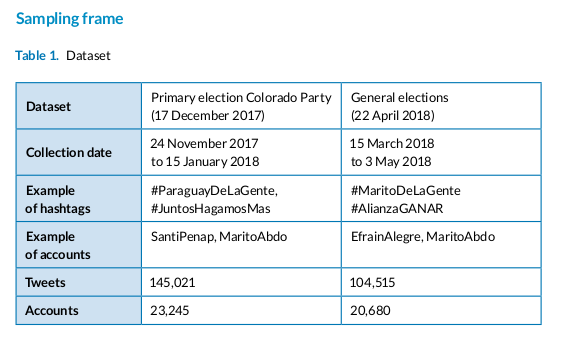
Description of Methodology
Colorado Party primaries: tweets were collected from November 24, 2017 to January 15, 2018,
using the Twitter API (Application Programming Interface). During this period, 145,021 tweets
published by 23,245 accounts were collected. Only tweets that used hashtags or mentions as-
sociated with electoral campaigns, candidates, lists or movements were collected. For example:
SantiPresidente, #ParaguayDeLaGente, @MaritoAbdo, #HonorColorado. Posts that did not use hashtags “#” or handles “@” were not considered for this study. Tweets published by presidential candidates were also included.
After the collection process, a labeling process followed. The labeling process means that each tweet was labeled with the name of a political movement according to the hashtag or mention used in the tweet (#Honor Colorado #Colorado Añetete). Tweets were also labeled according to the candidate they referred to (Santiago Peña, Mario Abdo). For example, if a tweet used
the hashtag #SantiPresidente (Honor Colorado candidate), the tweet was labeled as Santiago Peña and Honor Colorado. Tweets that referred to more than one movement or more than one candidate were labeled taking into account the movement or candidate with more hashtags or mentions in the tweet. A special tag was assigned to the tweet when the number of hashtags
and mentions for each movement or candidate was the same. Profiles that have never used campaign hashtags were classified as “neutral”.
Sentiment analysis: a tool called CCA-CORE 1 was used to run a sentiment analysis and examine the tone of the tweets. This analysis is used to check if the language used in posts has a positive or negative connotation. The limitation of this tool is that it does not process sarcasm or words in Guaraní.
General Elections: The methodology used for the primaries and the general elections is similar. Tweets were collected from March 15 to May 3 2018, using the Twitter API (Application Programming Interface). During this period, 104,515 tweets posted by 20,680 Twitter accounts were collected. Only tweets that used hashtags or mentions associated with electoral campaigns, candidates, lists or political parties were collected . For example: #AlianzaGANAR or #MaritoDeLaGente. The complete list of hashtags and profiles that were monitored can be found in this link. Publications that did not use hashtags “#” or handles “@” were not considered
for this study.
After the collection process, a labeling process followed. The labeling process means that each tweet was labeled with the name of a political movement according to the hashtag or mention they used in the tweet (#Alianza Ganar #). For example, a tweet was classified as associated with the Colorado Party if in its text it uses a hashtag of their electoral campaign or mentions the pro-
file of any of its candidates. Tweets that referred to more than one political party or more than one candidate were labeled taking into account the movement or candidate with more hashtags or mentions in the tweet. A special tag was assigned to the tweet when the number of hashtags and mentions for each move or candidate was the same. Profiles that have never used campaign
hashtags were classified as “neutral”.
Bot detector: The research team developed and used a tool called bot detector which identifies Twitter bot accounts based on a series of rules or heuristics. Given a user handle, the tool determines the probability of the user being a bot. The rules were derived from various articles that describe features of Twitter accounts used to share political propaganda or to influence public
opinion during electoral periods (Bhat and Phadte, 2017, Shaffer, 2017, Bessi and Ferrara, 2016). Some features are: default profile and cover image, random numbers or letters in the profile name, predominance of a single type of tweets (only replies, only retweets, etc.), deleting electoral content after the campaign, etc. The complete list of indicators can be found here.
The interactions network: the interactions that each account received were calculated. The network of interactions focuses on interactions received by each account and not on the relationship between the accounts (followers, followed). Interactions include retweets, responses, and quotes, as well as mentions of a handle. For example: Account A received an interaction
from Account B if (i) published a tweet mentioning A; (ii) retweeted a tweet published by A; (iii) quoted a tweet published by A; or (iv) responded to a tweet published by A.
Concepts
Bot: An account in a social network, usually on Twitter, robotized. This means that it works automatically. Sometimes there are many and they act in a coordinated way. They help generate noise on certain topics.
Troll: These are profiles that do have influence in the social network because they spread negative messages that generate many reactions on Twitter. Its only function in the network is to insult and threaten.
Fake Account: These are accounts that use a false identity to operate in the networks. Sometimes they are created with the aim of attacking others and establishing a topic of debate.
Research Findings
Colorado Party Primaries
The Colorado Party primary elections took place on December 17, 2017. During the elector al campaign, the most important political movements were Honor Colorado and Colorado Añetete. Honor Colorado was led by the then President Horacio Cartes and the main candidate of this movement was Santiago Peña. Mario Abdo was the presidential candidate of the opposition movement Colorado Añetete. Mario Abdo became the official candidate of the Colorado party for the general elections after winning the primaries with 50.93% of the votes. Santiago Peña got 43.29% of the votes.

This image contains 145,021 tweets that were shared from November 24, 2017 to January 15, 2018 and that used hashtags or handles to refer to electoral campaigns and candidates. The publication of tweets grew gradually until reaching its peak on Election Day (Dec. 17), this day over 30,000 tweets were posted. During Election Day, tweets related to Honor Colorado dominated the scene on Twitter, even after the Transmission of Preliminary Electoral Results (TREP) declared the victory of Mario Abdo, the presidential candidate of the Colorado Añetete. After the Election Day, there is a peak of activity on December 28, day on which the leader of Honor
Colorado, Horacio Cartes, confirmed that he would meet Abdo to support his presidential candidacy.
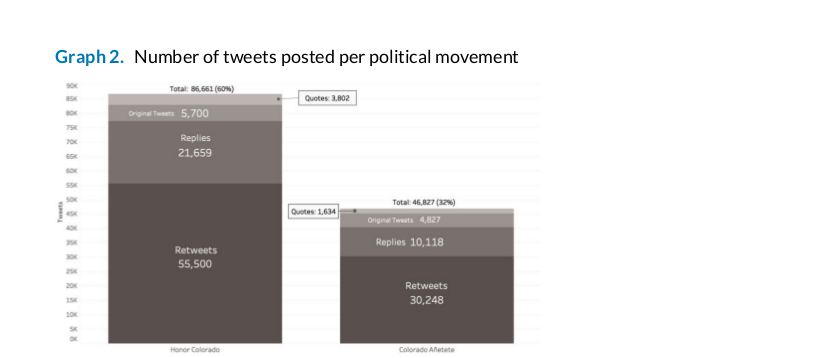
The movement Honor Colorado (HC) dominated the conversation on Twitter during the elec tion campaign. It did better than the rival movement Colorado Añeteté in number of tweets. Retweets were the most used type of tweet. Particularly in Honor Colorado, 60% of tweets with hashtags or accounts of the movement were retweets. Twitter was used mainly to spread electoral propaganda in favor of the movement and its candidates.
Furthermore, the sentiment analysis indicated that most tweets did not contain negative messages. Sentiment analysis is used to identify whether the language used in publications has a positive or negative connotation. According to this tool, only 15% of the tweets with reference to the presidential candidacies had a negative connotation. On Twitter, users talked more about
Honor Colorado and most of these comments were not negative. Even so, its candidate Santiago Peña did not win the primaries to run for president in the general elections. In other words, being “popular” on Twitter did not imply electoral victory.

The graph shows the content of tweets related to Honor Colorado and Colorado Añetete. By far, the most used content on posts was “plain text,” that is, letters, numbers and punctuation signs not accompanied by links, photos or videos. Only about 12% of the tweets contained photos and about 1% to 3% links or videos. Colorado Añeteté tweets used more images, videos, and links.
An analysis of the publications shows that around 50% of the links shared by Honor Colorado redirected the user to videos posted on sites such as YouTube or Facebook. Honor Colorado shared videos mainly through external sites while Colorado Añeteté used the native video functionality of Twitter. Around 30% of links shared by Colorado Añeteté were links to the facebook
chatbot of candidate Mario Abdo. A “chatbot” is a program that automatically answers questions made by the user. In this case, the chatbot was used as part of Mario Abdo’s political communication strategy so that voters could interact with his Facebook profile and ask about his campaign proposals. The remaining links mostly contained articles from well-known newspapers such as ABC or Última Hora.
During the primaries, only a small number of tweets contained links and these links did not come from dubious sources but rather from well-known media. Therefore, it is possible to conclude that during this period Twitter was not used to spread disinformation given that, generally, disinformation is based on posting links to websites with fabricated information meant to manipulate
public opinion.
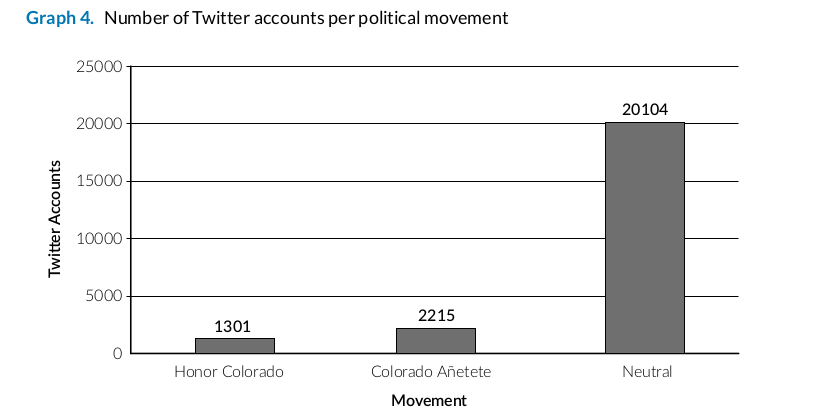
A total of 23,245 accounts posted tweets related to ANR’s primaries. Each of these accounts were labeled or classified according to their preferred movement taking into consideration the campaign hashtags or mentions used in their tweets. In total, 1,301 accounts supported Honor Colorado, while 2,215 supported Colorado Añeteté. Honor Colorado generated more content on Twitter; however, a larger amount of accounts backed Colorado Añetete by using its electoral campaign hashtags. Moreover, 86% of accounts that created content on Twitter were classified as “neutral”, which means they did not use campaign hashtags to support a movement but they
did talk about the primaries. Considering Honor Colorado generated more content with fewer affiliated accounts, one can conclude that neutral accounts created more content related to Honor Colorado and that the movement ́s related accounts were probably very active.

The “bot_detector” identified accounts with features of bots and fake accounts in both movements. Some of these features are: profile picture set by default, predominance of a single type of tweet (only replies, only retweets, etc.), elimination of electoral content after the campaign. Honor Colorado had more accounts with this behavior, 175 profiles that generated around 2% of the movement ́s content. On the other hand, 162 profiles associated with Colorado Añeteté (7% of the total) depicted behavior typical of bots and fake accounts. Bots from Colorado Añetete were seemingly more active than bots from Honor Colorado since they created around 4% of
the movement ́s tweets.
Retweets were the most common type of tweet used by these accounts. Nevertheless, they also created original content and answers. Elaborating answers, quotes and original content usually requires some human ingenuity. Therefore, it seems that many profiles with bot features alternated automated behaviors with human interaction. The sentiment analysis used to examine the tone of replies generated by bots found that most replies had no negative connotation. This indicates that bots and fake accounts were not used to organize smear campaigns or harass government critics. It is very likely that they were used primarily to publicize electoral campaigns.

Source: Retrieved from “ The importance of influential accounts during electoral periods” . Available: https://
medium.com/@jorgesaldivar/5b3fcf7614cd
n the interactions network, circles and names are used to illustrate accounts. The green circles represent the accounts that supported Honor Colorado by posting tweets with hashtags related to the movement ́s electoral campaign. Yellow is used to illustrate accounts that supported Colorado Añeteté. The color orange refers to accounts that at no time during the period of data extraction (November 2017 – January 2018) used campaign hashtags to support a political party.
The size of the circles and the profile names is proportional to the number of interactions the profile received. For instance, Marito Abdo, Horacio Cartes and Santiago Peña were prominent in the network due to the large number of interactions they received. That is, they were frequently mentioned and their tweets attracted an important volume of responses, retweets and
quotes. It is also possible to see that national journalists such as Santiago Gonzalez (Santula) and to a lesser extent Luis Bareiro were very influential.
General elections
Paraguay’s general elections took place on 22 April 2018. During the election campaign, the main presidential candidates were Mario Abdo of the Colorado Party (ANR), and Efrain Alegre from “Alianza Ganar”), a coalition composed by the Liberal Party (PLRA), Frente Guasu and other left-leaning parties. Since the beginning of the electoral campaign, most pollsters reported an advantage of over 23 points in favor of Abdo. Ati Snead was the only pollster in the entire process that reported a 1.7% advantage in favor of Alegre. Mario Abdo became the president of Paraguay with an advantage margin of 3.7%, he obtained 46.43% of the votes and Efraín Alegre
obtained 42.73% of the votes.
At first, Alegre claimed that there was fraud in the electoral process. He claimed that the Colorado Party changed ballot boxes’ results in polling stations, that there were some irregularities while loading results for the Preliminary Electoral Results Transmission System (TREP) and also criticized pollsters. Nevertheless, no formal complaint was filed and after one month the
candidate issued a statement accepting the defeat.
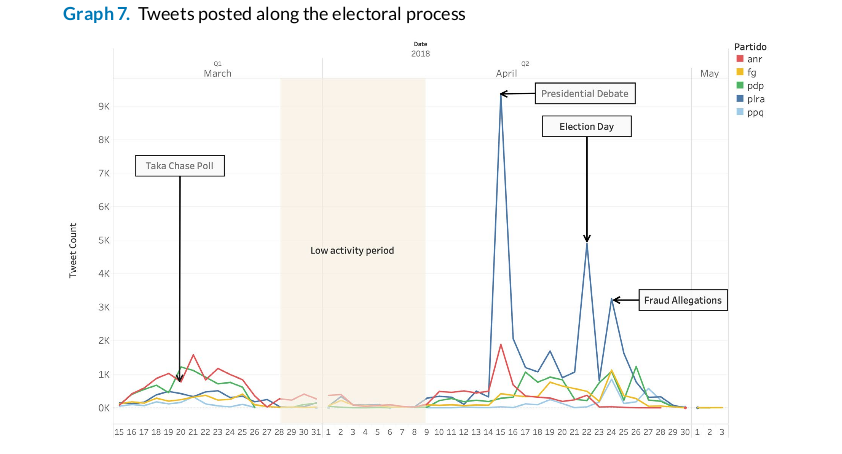
This graph contains 104,515 tweets shared from March 15 to May 3, 2018 that used hashtags or handles of campaigns and candidates. During the electoral process four different events generated four peaks of activity on Twitter. These events were the publication of the Taka Chase ́s electoral poll, the presidential debate held on April 15, the Election Day and fraud allegations.
During the debate, the elections and fraud complaints, most Twitter users and tweets talked about the Liberal Party (PLRA). On the other hand, the day Taka Chase ́s poll reported a 31% advantage of Mario Abdo over Efrain Alegre, most tweets mentioned the Colorado Party (ANR) and its candidate.
The impact of the presidential debate on Twitter is clear, this event motivated users to generate content for many days, as seen in the graph, the flow of content remains relatively high until it soars on Election Day. In contrast, the publication of several polls that reported Mario Abdo ́s huge advantage seems to have had the opposite effect and discouraged the debate mood of
users. The volume of content on Twitter decreased significantly after the third week of March, when polls carried out by Capli, Taka Chase and Ecodat were posted on Twitter. In all these polls Abdo had over 50% voting intention.

Graph shows the volume of conversation generated around each political party, ordered from left to right according to the number of seats they got in the Senate. The Liberal Party (PLRA) generated the largest amount tweets, followed by the Colorado Party (ANR), the Progressive Democratic Party (PDP) and Frente Guasu (FG). Retweets were the most used type of tweet during the electoral campaign followed by responses, original content and quotes.
The Liberal Party was the most popular party on Twitter. However, the “Coalition Ganar” (partly led by PLRA) did not win the presidential elections. The PLRA did not get the most seats in the Senate neither. Furthermore, the large amount of content and conversation generated by the PDP and its candidates did not translate into proportional electoral gain. Parties such as Patria Querida that were less famous on Twitter obtained more seats than PDP. In a nutshell, being “popular” on Twitter is not an indication of what will happen on Election Day.
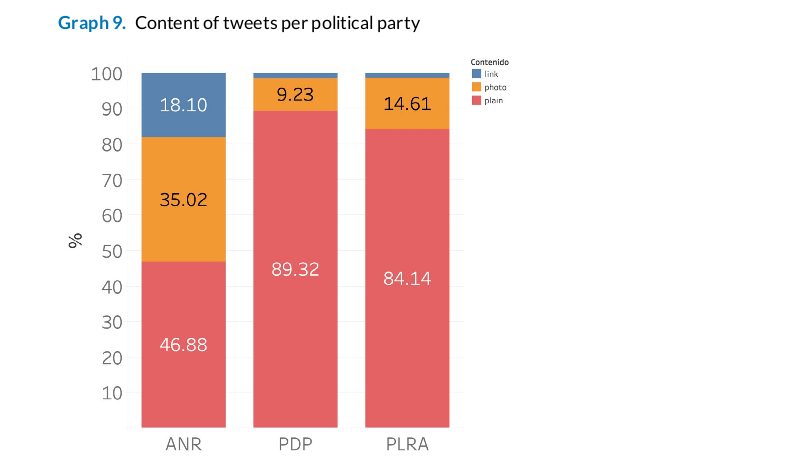
Graph 9 shows the percentage of tweets that contained links, photos or just text. The image includes information of tweets related to the ANR, PDP and PLRA which were the three most active parties on Twitter. Due to data collection limitations, tweets that used embedded videos such as live videos are not shown, although it is very likely that such videos were used as much as they were during the ANR ́s primaries.
The vast majority of tweets only had text and in general very few links to external sites were shared. The Colorado Party shared more photos and links, twice than the other parties. The links redirected the user mainly to Facebook or YouTube, and to well-known newspapers such as ABC Color, Última Hora and La Nación. During the general elections, only a small number of tweets contained links and these links did not come from dubious sources but rather from well known media. Therefore, it is possible to conclude that during this period Twitter was not used to spread disinformation given that, generally, disinformation is disseminated by posting links to websites with fabricated information meant to manipulate public opinion.
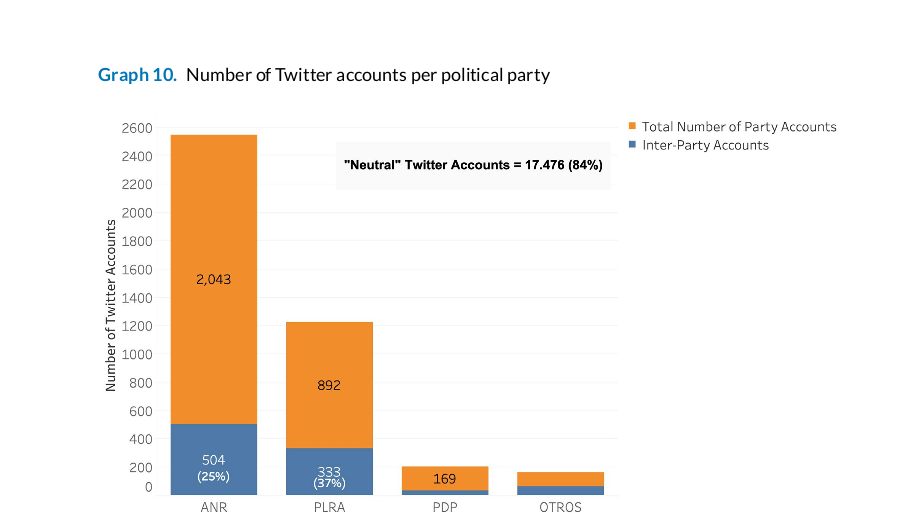
n total 20,680 accounts published tweets related to the general elections. Each of these accounts were labeled or classified according to their preferred political party, in other words, according to the party they endorsed using campaign hashtags. The vast majority of accounts (84%) were classified as “neutral”, which means that these accounts did not use campaign hashtags to support a political party. A large volume of content was created by these account, and it was probably their activity that influenced the conversation on Twitter the most.
In total, 2043 accounts supported the Colorado Party while 892 supported the Liberal Party. PLRA generated more content on Twitter; however, a larger amount of accounts backed the Colorado Party by using its electoral campaign hashtags. Considering that the Liberal Party generated more content with fewer affiliated accounts, one can infer that neutral accounts created more content related to them and that the party’s related accounts were very active.
Inter-party accounts and accounts with features of bots
The blue bar in the graph refers to inter-party accounts. These are accounts that explicitly claimed to support a political party, yet they focused on interacting with accounts that supported other political groups. Accounts with this behavior commonly write offensive or provocative comments to members of other political parties, therefore it is important to identify them in
order to spot signs of intimidation, harassment and violence. The Colorado Party had more accounts with this behavior, 504 or 25% of the total profiles. The PLRA had 333 profiles of this type, which corresponds to 37% of the accounts associated with the party. Our analysis, also included checking which accounts have features traditionally associated with fake or automated accounts (bots). Some accounts with these features were identified although their influence on the conversation was meager.

In the network of interactions, Twitter accounts are illustrated by circles and names. The red circles represent accounts that supported the Colorado Party (ANR) using their electoral campaign hashtags. Blue refers to accounts that supported the Liberal Party (PLRA). Green refers to accounts that showed preference towards the Progressive Democratic Party and gray is used
for neutral accounts which are accounts that at no time during the period of data extraction used campaign hashtags to support a political party.
The size of circles and profile names is proportional to the number of interactions the profile received. Therefore, accounts represented by large circles such as MaritoAbdo, EfraínAlegre and desimasi2 were frequently mentioned and their tweets got an important volume of answers, retweets, and quotes. In descending order, the politicians with most interactions were Efraín
Alegre, Mario Abdo, Desirée Masi, Leo Rubín and Camilo Soares. In addition, some national journalists were very influential. The tweets of the journalist Santiago González (Santula) generated more quotes, answers, or retweets. The accounts of Enrique Vargas Peña (enriquevp) and Estela Ruiz Díaz (Estelaruizdiaz) were also very influential.
Discussion, trends and challenges
Freedom on the Net report mentions that people increasingly rely on the use of internet, therefore it is important that the rights that exist offline are also protected online. Monitoring online activity can help protect certain rights such as freedom of expression and information. It can also help to prevent practices such as content manipulation, censorship, violence and intimidation.
To check the status of those rights and practices in Paraguay ́s elections, this study examines the generation of content on Twitter during electoral periods to look for signs of disinformation and manipulation. In addition, it looked for signs of violence, intimidation and censorship online paying attention to the language used in the tweets and which profiles were influential.
On the other hand, TEDIC research regarding the principle of Net Neutrality, which is a basic principle of Internet infrastructure that is regulated in the country, show that the zero-rating practices carried out by telephone service and Internet providers, affect the way in which people freely access the Internet and the way they consume information online. This context also impacts the analysis of Twitter during the elections in Paraguay, since the platforms that currently dominate the market, by violating this principle, focus on offering unlimited Facebook and/or whatsapp free of charge. The debate about elections in social networks is mainly carried
out in these content and messaging platforms offered free of charge, limiting the freedom of people to define how they access information regarding elections on the Internet and deepening inequalities when it comes to counteracting disinformation, limited information and censorship in platforms offered at no charge.
According to the data presented in this study, the generation of content on Twitter during primaries elections and general elections was similar. Currently, the generation of content on Twitter does not reflect what happens outside social media. As the report shows, the political groups that were most popular on Twitter did not win the elections. Moreover, there are no signs of high polarization since in both elections, over 80% of the accounts that generated content were “neutral” which means they did not support any political group. It was possible to identify accounts with features of bots and fake accounts in both elections. However, their activity was not influential. The accounts of national journalists were much more influential than any account with bot features. Finally, in both cases, the vast majority of tweets had only text, a smaller percentage had photos and links. The links contained articles published by well-known newspapers such as ABC Color, Última Hora and La Nación.
In conclusion, there were no signs of misinformation, manipulation, or generalized violence and censorship. The presence of bots and disinformation was low or non-existent; therefore they did not influence what happened inside or outside social media. There were no signs of high levels of violence, harassment or intimidation. As mentioned above, during the primaries only 15% of the
tweets referring to the presidential candidacies had a negative connotation. In addition, the great influence of different national journalists is a positive indicator of freedom of expression and low censorship. It is possible to say that in general, Twitter is a free and safe space during the electoralprocesses. Now, the main challenge is to continue monitoring the use of social media in order to
identify if the current dynamics change and decide how to address these potential changes.
The 2018 Freedom in the Net report provides information regarding the use of social media and internet in various democratic processes, which serves as a reference to understand what kind of challenges might emerge in the future. For example, some governments around the world are using “the prevention of disinformation during electoral processes” as an argument to re-
press dissidents, strengthen control over citizens’ data and limit internet access and quality by restricting broadband services during elections. Keep track of what happens in other countries can help to assess the applicability, scope and legitimacy of different policies and decide what to do in order to create a free, safe and inclusive digital space.
The second challenge is to ensure the quality of the electoral surveys and avoid that they are biased or used to censor debate. According to this study, the surveys published in 2018 were the events that had an undesirable impact on Twitter, these served as censorship agents of user’s activity. The generation of content on Twitter decreased after the successive publication of
electoral polls that reported an irreversible advantage in favor of Mario Abdo.
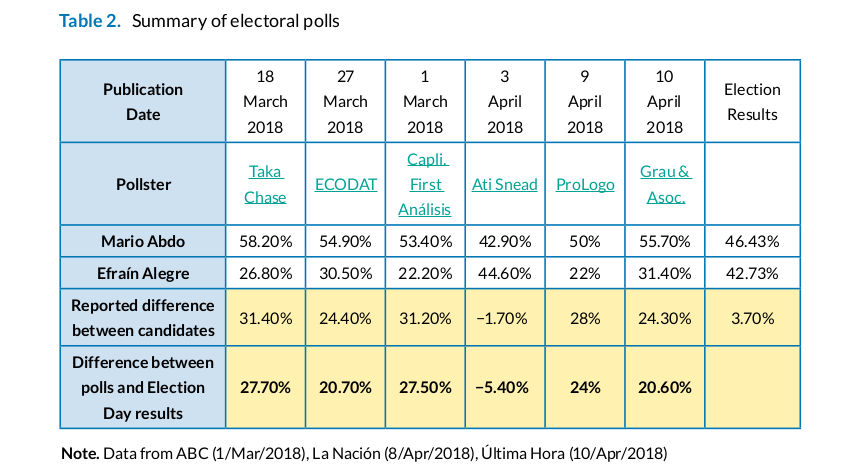
s seen in table 2, the difference between the candidates seemed irreversible and it is common knowledge that voters do not vote for the political group with bad prospects in polls. Therefore, these tools have the power to impact the election result and in the case of this study, the generation of content on Twitter. In 2018, senators proposed a law to regulate the disclosure of elector-
al polls; this law was approved by the congress but vetoed by President Mario Abdo. Therefore,thinking how to tackle this problem is still a pending task. In the meantime, voters must take into account that polls do not really determine what happens on Election Day and therefore feel free to express their opinions or preferences on social media.
Bibliography
ABC Color. “Mario Abdo veta de regulación de encuestas”, Diciembre de 2018. http:// www.abc.com.py/nacionales/veto-total-a-regulacion-de-encuestas-1765223.html.
Fernandez, Pablo. “‘El mundo secreto de los bots y los trolls… (y cómo esos ejércitos influyen en la política)’”, 13 de noviembre de 2017. https://www.chequeado.com/investigacion/el-mundo-secreto-de-los-bots-y-los-trolls-y-como-esos-ejercitos-influyen-en-la-politica/.
Freedom House. “Freedom on The net Report 2018. The rise of Digital Authoritarianism.” Freedom House, 2018. https://freedomhouse.org/sites/default/files/FOTN_2018_Final%20Booklet_11_1_2018.pdf.
Howard, Bradshaw. “Trolls and Troublemakers: A Global Inventory of Organized Social Media Manipulation.” Computational Propaganda Project, University of Oxford, 2017. http://comprop. oii.ox.ac.uk/wp-content/uploads/sites/89/2017/07/Troops-Trolls-and-Troublemakers.pdf.
Karisma, Fundación. “¿Cómo se contrata en América Latina el acceso a Internet?” TEDIC, junio de 2016. https://www.tedic.org/wp-content/uploads/2016/06/Informe-ISOC-Final-jun-27.pdf.
Laconich, M. Trepowski, C. Saldivar, J. “El rol de Twitter en las elecciones generales de Paraguay”. TEDIC, 15 de Enero del 2019. https://www.tedic.org/ el-rol-de-twitter-en-las-elecciones-generales-de-paraguay-2018/
La Nación. “Tres de cuatro encuestas dan ganador a Abdo frente a Alegre Mario Abdo Benítez y Efraín Alegre.”, Abril de 2018. https://www.lanacion.com.py/destacado_edicion_impresa/2018/04/08/tres-de-cuatro-encuestas-dan-ganador-a-abdo-frente-a-alegre/.
Saldivar, Jorge. “Redes Sociales en tiempos electorales”. Medium (blog), https://medium.com/@jorgesaldivar/89f2925966b6.
Saldivar, Jorge. “La importancia de perfiles influyentes en procesos electorales”. Medium (blog), 2018. https://medium.com/@jorgesaldivar/5b3fcf7614cd.
Wolley y Howard. “Computational Propaganda Worldwide: Executive Summary.” Computational Propaganda Project, University of Oxford, 2017.
